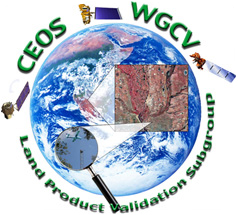
Focus Area on Biophysical Product Validation
Luke Brown, University of Salford, UK
Richard Fernandes, Natural Resources Canada
Hao Tang, National University of Singapore
LAI and fAPAR Definitions
The biophysical focus area includes two variables at this time: leaf area index (LAI) and the fraction of absorbed photosynthetically active radiation (fAPAR).
Leaf area index is defined as one half the total green (i.e., photosynthetically active) leaf area per unit horizontal ground surface area.This definition, based on Chen and Black (1992), was accepted by GCOS, GTOS and CEOS in 2009. However, relatively to the way it is measured on the ground or derived from the satellite data, different definitions of LAI can be considered when derived from remote sensing instruments: GAI (Green Area Index, same definition as LAI but includes all the green elements, e.g., stems, ears,…), PAI (Plant Area Index, includes all elements, green and non-green).
The fraction of absorbed photosynthetically active radiation (fAPAR) is defined as the fraction of photosynthetically active radiation (PAR; solar radiation reaching the surface in the 0.4-0.7µm spectral region) that is absorbed by vegetation. This definition was accepted by GCOS, GTOS and CEOS in 2009.
fAPAR actually corresponds to the sum of two terms, weighted by the diffuse fraction in the PAR domain: the 'black sky' fAPAR that corresponds to the direct component (collimated beam irradiance in the sun direction only) and the 'white sky' or the diffuse component. The closest approximation to white sky/diffuse fAPAR occurs under a deep cloud cover that may generate an almost isotropic diffuse downward radiation. The adjectives of black and white are not related here to the color of the sky, but to the angular distribution of light intensity (see Martonchik et al., 2000 for more details).
fAPAR can be considered at a given time (e.g., instantaneous fAPAR at the actual sun position of measurement) or daily integrated. All the vegetation elements contribute to PAR absorption, including the green elements (leaves, stems and other parts) for photosynthesis as well as other non-green elements such as trunks, senescent material, flowers, …
Note that fAPAR can be approximated by the fIPAR (fraction of Intercepted PAR radiation), by considering that the leaves are black in the PAR domain.
Units: LAI is a non-dimensional quantity, although units of m2/m2 are often quoted.
fAPAR is expressed as a unitless fraction of the incoming radiation received at the land surface.
Highest Validation Stage Currently Reached for Satellite-Derived LAI and fAPAR Products
Validation stage 2 (LPV validation stage hierarchy) - The highest LPV validation stage reached for satellite-derived LAI and fAPAR products. Limitations to reach higher validation stage include limited number of validation sites, spatial and temporal gaps of in situ reference data coverage. LPV is collaborating with NEON, TERN, and ICOS to improve coverage of in situ reference data.
Note that less in situ measurements are available for fAPAR, which are mostly correspond derived from DHP measurements (and therefore actually correspond to fIPAR, see Definitions).
The BELMANIP2 sites ensure the fAPAR product inter-comparison over globally representative locations and time periods.
Validation Good Practices
The LPV Subgroup has just published a Good Practices Protocol document for validation of LAI Products. The document is available for download along with associated documents:
Fernandes, R., Plummer, S., Nightingale, J., Baret, F., Camacho, F., Fang, H., Garrigues, S., Gobron, N., Lang, M., Lacaze, R., LeBlanc, S., Meroni, M., Martinez, B., Nilson, T., Pinty, B., Pisek, J., Sonnentag, O., Verger, A., Welles, J., Weiss, M., & Widlowski, J.L. (2014). Global Leaf Area Index Product Validation Good Practices. Version 2.0. In G. Schaepman-Strub, M. Román, & J. Nickeson (Eds.), Good Practices for Satellite-Derived Land Product Validation (p. 76): Land Product Validation Subgroup (WGCV/CEOS), doi:10.5067/doc/ceoswgcv/lpv/lai.002
(Download CEOS_LAI_PROTOCOL_Aug2014_v2.0.1.pdf, 5MB)
Validation Reference Data Sets
The DIRECT V2.1 database compiles Leaf Area Index (LAI), fraction of absorbed photosynthetically active radiation (FAPAR) and fraction of vegetation cover (FCover) averaged values over a 3 km x 3 km area. The ground data were upscaled using high-resolution imagery following the LPV LAI good practices protocol to properly account for the spatial heterogeneity of the sites.
Ground measurements included in the original DIRECT dataset were a result of several international activities, including VALERI, BigFoot, SAFARI-2000, CCRS, Boston University and ESA campaigns compiled by S. Garrigues (Garrigues et al., 2008). These were later ingested in the LPV OLIVE tool (Weiss et al., 2014) for accuracy assessment. The DIRECT sites were reviewed by F. Camacho to remove sites lacking understory measurements (Camacho et al., 2013). In an effort several years later, the sites were expanded and incorporated into a database with ImagineS sites (Camacho et al., 2021). DIRECT V2.1 is the latest update, that includes 44 new sites from China (Fang et al., 2019; Song et al., 2021) and 2 new sites from ESA FRM4Veg (Brown et al., 2021).
The CEOS WGCV LPV DIRECT V2.1 database constitutes a major effort of the international community to provide ground reference for the validation of LAI and FAPAR ECVs, with a total of 176 sites around the world (within 7 main biome types) and 280 LAI, 128 FAPAR and 122 FCover values spanning the period from 2000 to 2021.
Additional details and access to the new LPV DIRECT 2.1 dataset can be found on the WGCV Cal/Val portal page dedicated to DIRECT V2.1.
Additional ground-based measurements are available through the following links:
LPV Focus Areas
Meetings
Land Product Validation and Evolution, June 12 -14, 2023 ESA/ESRIN, Italy.
IGARRS 2023, 16-21 July 2023, Pasadena, CA. Abstract submission due 18 Nov 2022.
EGU 2023, 23-28 April 2023, Vienna, Austria. Abstract submission due 10 Jan 2023.
- NASA Official: Sadashiva Devadiga
- Website Manager: Jaime Nickeson
- Last Updated: April 16, 2024


